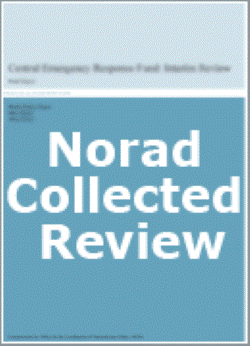Midterm Review of RSA-3001: South African Energy Sector Policy research and capacity Development Programme
Om publikasjonen
- Utgitt: november 2009
- Serie: Norad-innsamlede rapporter
- Type: --
- Utført av: Econ Pöyry AS
- Bestilt av: Royal Norwegian Embassy, Pretoria
- Land: Sør-Afrika
- Tema: Energi og infrastruktur, Utdanning og forskning
- Antall sider: 66
- Serienummer: 12/2009
- ISBN: 978-82-7548-440-4
- ISSN: --
- Prosjektnummer: RSA - 3001

The Project
The Programme builds on two previous phases of energy cooperation between Norway and South Africa, started in 1998. The total budget frame of the current three year period, 2006-2009 is a maximum of NOK 35 mill. The programme, with considerable delay in spending, was granted a short extension of the time frame. The programme has several sub programmes, hydrocarbons (downstream), electricity, upstream petroleum, alternative energy, energy regulation. Several South African institutions have been involved, with DME (Chief Directorate of Hydrocarbons) as main programme manager since 2007. NVE, Norwegian Water resources and Energy Directorate, and NPD, Norwegian petroleum Directorate are Norwegian participating institutions.
Interesting Findings
- Approximately half the Programme grant has been spent by end-March 2009. However, completion and expenditure rates were broadly similar to those of South African institutions’ internal projects. Although the Embassy expressed disappointment at lack of progress, achievements should be placed in perspective. Most SA institutions stated that completion and expenditure rates on the Programme were broadly similar to those of comparable internal projects.
- Major factors for under-achievement:
- The Programme was diverse and its management structure complicated.
- Outsourcing the Programme Manager may have improved efficiency but probably undermined DME ownership.
- DME became a bottleneck.
- Most Sub programme institutions lacked project management skills.
- DME was pre-occupied by ‘fighting fires’ (energy emergencies in the country, including power blackouts).
- Reporting to the Embassy was not sufficient to enable it to follow the Programme. Reporting procedures agreed in the Programme Business Plan appear to have been adequate for this purpose but were not fully followed/enforced.
- There were no consequences for lack of progress, while large monetary transfers led to unspent balances, which may have undermined incentives to make progress. - Most respondents said that Norwegian funds represented an important addition to their budgets. Additional funds allowed SA institutions to expand the list of priorities they could address and/or concentrate more intensively on particular priorities. The Programme allowed participating SA institutions to take advantage of more expensive and (they felt) better quality expertise than otherwise would have been the case. Several interviewees commented that, even after the Programme comes to an end, a lasting benefit will be the Norwegian professional acquaintances they have made and whom they now feel they will be able to contact for further advice.
- The Programme is helping put into place several systems and outputs that will outlast the Programme. Among others, the Programme will have helped put into place a pricing policy framework for electricity; a distribution quality-of-supply database covering stadium sites within the cities that will host the 2010 football World Cup; a system for Petroleum Regulatory Accounts; implementation of a petroleum licensing system; a database of existing onshore geological information; an inventory of South Africa’s oil and gas resources; and South Africa’s continental shelf extension application to the UN.
